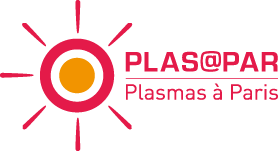
Highlights
The Solar Orbiter mission: immediate liftoff
On February 10, 2020, thanks to the European Space Agency (ESA), the Solar Orbiter space mission has been launched from Cap Canaveral.
The mission launched with the ATLAS V rocket (in collaboration with NASA) carries 10 scientific intruments, among which several have been designed in 2 laboratories members of the PLAS@PAR Research Federation in Plasma Physics: LESIA1 (Laboratoire d'Études Spatiales et d'Instrumentation en Astrophysique) and LPP2 (Laboratoire de Physique des Plasmas).
A long-standing quest
There has been a few probes orbiting the Sun but nothing similar to what Solar Orbiter will achieve in the coming decade.
In the late 70’s, the Helios mission came nearby in the ecliptic plane. Then the ULYSSES mission in the 90’s flew over the poles of our star. But none of them had Solar Orbiter capabilities to look at the Sun and at the same time to measure the solar wind escaping from it.
Why did ESA develop such an ambitious mission?
Solar Orbiter is a mission that will last 7 to 10 years, it will fly over Venus several times and spend long periods near our star studying questions related in particular to the heliosphere and the solar winds, that are long-standing investigations.
Solar Orbiter is an emblematic and very ambitious mission for ESA because of its proximity with the Sun. Parker Solar Probe and Solar Orbiter will work together: the european probe will help to visualize the space environment in which the American probe will collect data at an even closer distance from the sun (7 million km).
Solar Orbiter’s scientific goals
During the overflights of Venus, Solar Orbiter will have to gradually lower its orbit. The satellite will gradually increase its inclination compared to the ecliptic plane to reach an inclination up to 33 degrees. The mission should answer questions such as:
- How does the magnetic field emerge from the inside and what is its impact on the solar atmosphere?
- What are the mechanisms involved in the formation of the corona and the solar wind?
- What are the physical processes explaining the eruptive activity of the sun?
Understanding the mechanism of solar flares would help to better predict solar storms and the disturbing effects on Earth and on our satellites.
LPP and LESIA contributions
6 French laboratories participated in the design of part of the mission’s scientific equipment, 2 laboratories members of PLAS@PAR Research Federation actively contributed to the development of several instruments: LESIA and LPP.
The Laboratoire de Physique de Plasmas (LPP) designed and produced both the RPW LFR (Low Frequency Receiver) subsystem for on-board processing of electromagnetic wave measurements and the electron detection system of the EAS (Electron Analyzer Sensor) spectrometer of the SWA (Solar Wind Analyzer) instrument. The LFR analyzer is based on a low power FPGA digital signal processor. It reduces the amount of data transmitted to the ground while optimizing the scientific value. It delivers a wide range of products ranging from simple waveforms to sophisticated spectra. The EAS detection system incorporates new-generation ASIC-type electronics that have miniaturized the instrument while providing high angular resolution measurements of the electrons in the solar wind.
The Laboratoire d’Études Spatiales et d’Instrumentation en Astrophysique (LESIA) is responsible (PI) for the RPW (Radio & Plasma Waves) instrument developed and designed by the Centre national d'études spatiales (CNES).
The RPW instrument consists of a complex electronic box of 7 kg in the heart of the probe, well protected by its heat shield, and connected to several types of external sensors: the magnetic sensor SCM, located on the mast of the satellite with a distance of two meters from the platform, and three 6.5 m long electric antennas. The instrument measures the magnetic and electric fields in the vicinity of the probe in order to study the dynamics of the solar wind, this jet of charged particles - plasma - emitted by our star.
The LESIA is also involved in the STIX spectro-imager which will provide spectra and X-ray images produced by hot plasmas and energetic electrons produced during solar flares.
1Observatoire de Paris – PSL/CNRS/ Sorbonne Université/Université de Paris
2CNRS/École Polytechnique/Sorbonne Université/Université Paris-Saclay/Observatoire de Paris – PSL
